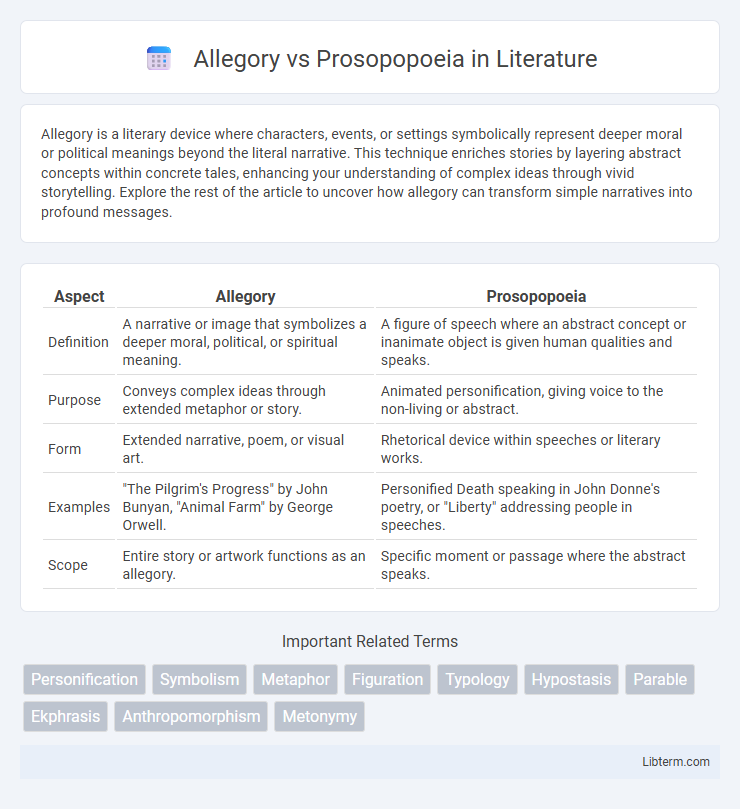Allegory is a literary device where characters, events, or settings symbolically represent deeper moral or political meanings beyond the literal narrative. This technique enriches stories by layering abstract concepts within concrete tales, enhancing your understanding of complex ideas through vivid storytelling. Explore the rest of the article to uncover how allegory can transform simple narratives into profound messages.
Table of Comparison
| Aspect | Allegory | Prosopopoeia |
|---|---|---|
| Definition | A narrative or image that symbolizes a deeper moral, political, or spiritual meaning. | A figure of speech where an abstract concept or inanimate object is given human qualities and speaks. |
| Purpose | Conveys complex ideas through extended metaphor or story. | Animated personification, giving voice to the non-living or abstract. |
| Form | Extended narrative, poem, or visual art. | Rhetorical device within speeches or literary works. |
| Examples | "The Pilgrim's Progress" by John Bunyan, "Animal Farm" by George Orwell. | Personified Death speaking in John Donne's poetry, or "Liberty" addressing people in speeches. |
| Scope | Entire story or artwork functions as an allegory. | Specific moment or passage where the abstract speaks. |
Introduction to Allegory and Prosopopoeia
Allegory is a literary device where abstract ideas and principles are represented through characters, events, or narratives to convey deeper moral or political meanings. Prosopopoeia specifically personifies abstract concepts, inanimate objects, or absent figures, giving them human traits or speech to enhance vividness and emotional impact. Both techniques enrich storytelling by transforming intangible themes into relatable, concrete forms that engage readers on multiple levels.
Defining Allegory: Meaning and Usage
Allegory is a literary device in which abstract ideas or moral qualities are represented through characters, events, or symbols, creating a narrative with a deeper meaning beyond the literal. It is often used to convey complex concepts such as good versus evil or political commentary through an extended metaphor. Unlike prosopopoeia, which gives voice to inanimate objects or abstract notions, allegory constructs a cohesive story or framework to illustrate its intended message.
Understanding Prosopopoeia: Concept and Application
Prosopopoeia is a rhetorical device that personifies abstract concepts, inanimate objects, or absent entities by giving them human characteristics or speech, enhancing emotional engagement and vivid imagery. Unlike allegory, which represents broader ideas through extended narratives or symbolic figures, prosopopoeia focuses on direct speech or actions attributed to non-human subjects, making complex ideas more relatable and memorable. This technique is widely employed in literature, speeches, and advertising to animate concepts like justice, time, or nature, thereby deepening audience connection and interpretive depth.
Historical Origins of Allegory and Prosopopoeia
Allegory traces its origins to ancient Greek philosophy and literature, with Plato's dialogues often cited as early examples that use symbolic narratives to convey abstract ideas. Prosopopoeia, derived from the Greek term "prosopon" meaning "face" or "mask," emerged in classical rhetoric as a device where inanimate objects or absent persons are given voice, notably used in the works of Cicero and Quintilian. Both devices evolved as powerful tools in classical and medieval literature, shaping moral and philosophical discourse through personification and symbolic storytelling.
Key Differences Between Allegory and Prosopopoeia
Allegory represents abstract ideas or principles through extended symbolic figures, narratives, or imagery, conveying complex meanings beyond the literal level. Prosopopoeia specifically involves giving voice or speech to an inanimate object, absent person, or abstract concept, enabling it to speak or express thoughts directly. The key difference lies in allegory's broad narrative symbolism versus prosopopoeia's focused rhetorical device of personification through speech.
Literary Functions of Allegory
Allegory functions primarily as an extended metaphor, where characters, events, and settings symbolically represent abstract ideas or moral qualities, allowing readers to derive deeper meanings beyond the literal narrative. It facilitates complex storytelling by communicating philosophical, ethical, or political messages through layered symbolism. Unlike prosopopoeia, which involves giving voice to inanimate objects or abstractions, allegory creates an entire structured world of symbolic representation to explore universal truths and social critiques.
Rhetorical Power of Prosopopoeia
Prosopopoeia wields significant rhetorical power by giving voice to abstract concepts, inanimate objects, or absent figures, thus creating vivid and persuasive narratives that engage audiences emotionally and intellectually. Unlike allegory, which represents ideas through symbolic characters or stories, prosopopoeia directly animates ideas through personification, making arguments more relatable and impactful. This technique enhances persuasion by evoking empathy and delivering messages with a dynamic sense of presence and immediacy.
Famous Examples in Literature
Allegory is exemplified in George Orwell's "Animal Farm," where animals symbolize political figures and ideologies, creating a layered narrative about totalitarianism. Prosopopoeia appears vividly in John Milton's "Paradise Lost," where abstract entities like Sin and Death speak and act as characters. Both techniques enrich literature by personifying ideas, but allegory structures an entire narrative symbolically, while prosopopoeia animates specific concepts or inanimate objects through speech.
Impact on Reader Interpretation
Allegory engages readers by conveying complex ideas through symbolic narratives, prompting deeper reflection on abstract themes beyond the surface story. Prosopopoeia, by giving voice to inanimate objects or abstract concepts, personalizes the message, creating an immediate emotional connection that shapes reader empathy. Both devices influence interpretation by transforming intangible notions into relatable experiences, but allegory encourages thematic analysis while prosopopoeia fosters vivid imaginative engagement.
Conclusion: Choosing the Right Device
Selecting between allegory and prosopopoeia hinges on the communicative goal and desired impact on the audience. Allegory excels in delivering complex ideas through extended metaphorical narratives, fostering deep reflection. Prosopopoeia animates abstract concepts or inanimate objects by giving them voice, creating vivid, immediate emotional engagement.
Allegory Infographic

 libterm.com
libterm.com